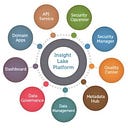Automated Migration of Apache Kafka to Confluent Cloud for a Leading Commercial Insurance Firm
Introduction
In today’s fast-paced digital landscape, commercial insurance firms must leverage advanced streaming technologies to stay competitive. One leading commercial insurance firm recognized the need to modernize its streaming architecture by migrating from Apache Kafka to Confluent Cloud. The firm chose InsightLake Kafka Migration Automation to ensure a seamless, efficient, and error-free migration process. This blog post will delve into the details of this automated migration, highlighting the steps taken and the benefits realized.
Assessment of Existing Streaming Architecture
The migration journey began with a thorough assessment of the firm’s existing streaming architecture. InsightLake Kafka Migration Automation performed an in-depth analysis of the current setup, including:
- Data Management: Evaluation of existing topics, schemas, partitions, and data flow.
- Security: Review of encryption methods, authentication protocols, authorization mechanisms, and secrets management.
- Governance: Assessment of data governance policies, data lineage, and compliance requirements.
- Operations: Examination of monitoring, logging, and DevOps practices.
- Data Pipelines: Analysis of data integration tools, connectors, and existing pipelines.
The assessment provided a comprehensive understanding of the existing environment, forming the foundation for the migration plan.
Capacity Planning for Confluent Cloud
Based on the assessment, InsightLake Kafka Migration Automation created a detailed capacity plan for Confluent Cloud. This plan included:
- Cluster Sizing: Determining the number of Confluent Kubernetes Units (CKUs) required for optimal performance.
- Dedicated Cluster: Configuring a dedicated Confluent Cloud cluster to meet the firm’s specific needs.
- VPC Peering: Implementing VPC peering for secure and efficient data transfer between the firm’s on-premises infrastructure and Confluent Cloud.
Migration of Users
Migrating existing users to Confluent Cloud was a critical step. InsightLake Kafka Migration Automation facilitated:
- User Authentication: Transitioning from SASL_PLAINTEXT to more secure authentication methods supported by Confluent Cloud.
- Authorization: Implementing Role-Based Access Control (RBAC) to manage user permissions and ensure data security.
- Secrets Management: Integrating GCP Secrets Manager for managing sensitive information.
Changes to Producers and Consumers
The automation tool made necessary changes to the producers and consumers to ensure compatibility with Confluent Cloud. Key modifications included:
- Configuration Updates: Adjusting configurations for producers and consumers to align with Confluent Cloud requirements.
- Code Adjustments: Updating code to utilize Confluent Cloud-specific features and APIs.
- Testing and Validation: Performing rigorous testing to ensure smooth data flow and functionality.
Data Integration Tools and Connectors
Data integration tools and connectors were also migrated to Confluent Cloud. This process involved:
- Connector Migration: Transitioning existing connectors, such as GCS Sink and BigQuery Sink, to Confluent Cloud Managed Connectors.
- Integration Testing: Ensuring seamless integration between on-premises systems and Confluent Cloud.
- Configuration Management: Managing connector configurations through the Confluent Cloud interface.
Data Replication Using Replicator
To ensure data consistency and availability, InsightLake Kafka Migration Automation used Confluent Replicator to replicate data from the on-premises Kafka cluster to Confluent Cloud. This step included:
- Data Synchronization: Continuous synchronization of data between the source and target clusters.
- Replication Monitoring: Monitoring replication status and performance to ensure data integrity.
- Failover Mechanisms: Implementing failover mechanisms to handle any replication issues.
Use Case-Based Switchover and Shutdown of On-Premise Pipelines
The migration process involved a use case-based switchover, ensuring minimal disruption to business operations. Steps included:
- Switchover Planning: Creating a detailed plan for switching over specific use cases to Confluent Cloud.
- Gradual Transition: Gradually transitioning use cases to the new environment to minimize risk.
- Pipeline Shutdown: Shutting down on-premises pipelines once the switchover was successfully completed.
Implementation of New GitOps-Based Pipelines
To streamline future operations, new GitOps-based pipelines were implemented. These pipelines covered:
- Schema Management: Automated management of schemas using GitOps principles.
- Topic Management: Automation of topic creation and configuration.
- User Onboarding: Streamlined process for onboarding new users.
- CI/CD Integration: Integration with continuous integration and continuous deployment (CI/CD) pipelines for automated deployments.
Migration of Monitoring Using Prometheus and Grafana
The firm migrated its monitoring setup to Confluent Cloud, utilizing Prometheus and Grafana. Key steps included:
- Metric Collection: Configuring Prometheus to collect metrics from Confluent Cloud.
- Dashboard Creation: Setting up Grafana dashboards to visualize key metrics and monitor system health.
- Alerting: Implementing alerting mechanisms to notify the operations team of any issues.
Conclusion
The automated migration of the commercial insurance firm’s streaming architecture from Apache Kafka to Confluent Cloud was a resounding success. Using InsightLake Kafka Migration Automation, the firm achieved a seamless transition with minimal disruption. The new Confluent Cloud setup offers improved performance, enhanced security, and streamlined operations, positioning the firm for future growth and innovation in the streaming landscape.
